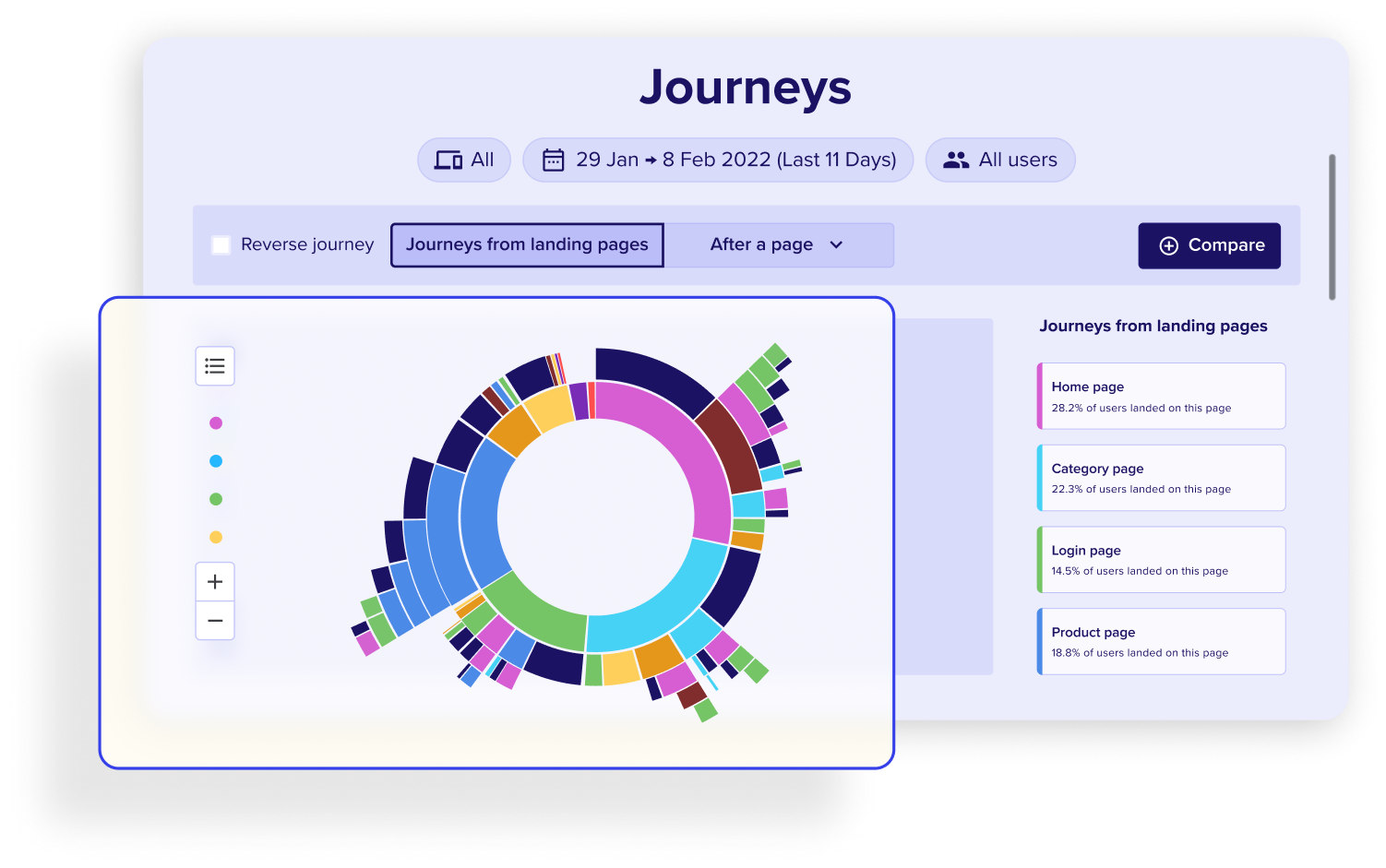2023 Digital Experience Benchmark Explorer
This year’s Digital Experience Benchmark includes an interactive explorer which puts the most relevant benchmarks for digital customer experience (CX) in your hands.
to see how you stack up against your peers—and leverage the learnings to be better armed for digital growth in the year ahead.

161

35

2,942

26

9
While overall traffic grew, metrics relating to the rest of the customer journey wound up in the red across most industries. Despite the gain in traffic, more bounces and fewer page views per session curbed conversion, which fell nearly as far as traffic rose.
Q4 2022 / Q4 2021, Same site activity
The good, the bad and the frustrating
It’s often difficult to measure the quality of a digital experience—and attempts to do so tend to be too narrowly focused on outcomes.
By taking a deeper look into the elements that precede (and underpin) outcomes—activity and frustration—you uncover the real human experience that drives every customer journey.
Activity across the journey
Higher activity is tied to deeper sessions and lower bounce rate—and lowering bounce rate provides you with more opportunities to engage and inspire your customers to act.
Those points of friction along the journey that create frustration and detract from your experience.
Rage click
Slow loading time
Multiple button interactions
Multiple field interactions
Multiple use target
Low activity
The Troublemakers
One in five sessions is slow to load—and slow loading sessions are a severe sore spot in digital. Sessions with slow page loads are more likely to terminate in a bounce and earn fewer page views.
The Troublemakers
One in five sessions is slow to load—and slow loading sessions are a severe sore spot in digital. Sessions with slow page loads are more likely to terminate in a bounce and earn fewer page views.
Traffic and visitor segmentation
As digital evolves, traffic patterns change. It’s critical that teams stay attuned to this natural shift—not least as it helps to ensure they’re taking an efficient approach to attracting visitors.
Traffic and new visitor share by source
While emerging marketing channels get the headlines, paid and organic search continue to quietly dominate the digital landscape. Combined with direct traffic, these three sources deliver 2 of 3 visits to sites.
Social channels account for nearly double digit traffic share—most of which is from mobile, though that share has barely nudged over the past year.
Traffic share by device
It may be a stale story, but it still has to be emphasized—the great mobile migration rolls on, with mobile continuing to take share from desktop.
Mobile-first needs to be your organizing principle, whether you’re designing internal processes, optimizing experiences, or, even overhauling the overall expectations for your digital KPIs.
Traffic by category (paid unpaid), by device, filtered by industry
The cost of attraction continues to creep up, with paid traffic sources accounting for a larger slice of digital traffic than ever. Paid traffic tends to skew mobile and attracts a higher share of new visitors than organic.
While the cost of paid traffic rose throughout the year, performance trended down, with conversion from paid traffic sources tumbling -2.9% YoY in Q4.
Conversion rate by traffic source, device and industry
Across all industries, the direction of conversion rate was nearly unanimously down.
The lone bright spots came from social sources, both organic and paid on desktop (where little social traffic originates) and paid social on mobile. Overall, conversion rates suffered declines for nearly all traffic sources across both devices.
Session consumption
‘How much’ content visitors are consuming is readily quantified across the site journey, but can be viewed and interpreted across a variety of dimensions. The following measures each reveal a particular window into consumption, from breadth to depth.
Session depth is likely the most established of consumption measures—but that doesn’t mean it’s stable
In fact, it’s been in flux throughout 2022. As more traffic moves to mobile (on which sessions tend to leave a shallower page footprint) overall session depth will naturally recede.
Even on mobile, though, session depth dropped this year, in line with an ongoing trend amongst visitors towards making more frequent but shorter visits (a.k.a. ‘grazing’).
Our analysis shows that more than half of a page is typically going unseen and untouched. But what should digital teams do about this?
Designing the digital experience requires a rational view of what the visitor is exposed to. And so, just as print media popularized the adage ‘above the fold’ (placing the call to action on the top half of the front page), digital needs to carefully consider what goes ‘above the scroll’.
Scroll rate shortened up this year, which begs the question: is the typical page half scrolled or half unscrolled?
Whether you take the optimist’s or pessimist’s view, here, the reality is that visitors are typically exposed to only half of the page that digital is drawing—and this strengthens the argument for pulling compelling content, offers and CTAs higher up in the page.
Across the entire journey, digital has an exposure challenge
While the most popular page type varies by industry, every industry shares this in common: less than half of all visitors see no more than one or two different page types and only one or two page types will be seen by more than half of your visitors.
This is the sort of insight that often gets lost in an aggregate view of your journeys: that visitors typically can’t and don’t see much of your site during a journey.
Time spent is an important measure for understanding how long you keep the attention of the visitor
While the notion of a visitor’s time being constrained is not new, this year’s -7.5% reduction in session duration is another clear sign that visits are short-lived.
Session outcomes
The success or failure of a session is most frequently judged by its outcome. From bounce to conversion, here are the cross-industry trends for digital destinations.
Bounce rate by device, by industry
Bouncing is the worst possible outcome of a digital session. When visitors bounce, it means they’ve only viewed one page before exiting—and there’s nearly no value in this for digital teams.
The ROI of a bounce is all ‘I’ (investment), no ‘R’ (return). And unfortunately, bounce rates are rising across digital.
Bounce rate by quarter, by device, by industry
Overall, more than half of visits bounce. Mobile bounces are about 5 percentage points higher than desktop—which is concerning, given that traffic is continuing to migrate to mobile.
Conversion rate by quarter, by device, by industry
Of all the digital metrics, conversion rate is the one most likely to be ensconced at the top of a company’s dashboard. It’s also likely to be the one measure that the entire digital organization speaks fluently.
But conversion rate needs to be treated with caution: it’s a highly context-dependent metric, shifting based on the traffic and consumption metrics outlined above, and varying across device and industry.
Summary
The key Digital Experience metrics
“What gets measured gets managed.”
When it comes to enhancing the digital experience, the cliché holds true. But many digital leaders are awash in data and struggle to separate the valuable from the measurable.
Activity
measures the attention a visitor pays to your site via the clicks, taps and hovers they make across the journey. You should encourage activity in your journeys; sites with high rates of activity ward off bounces and encourage deeper (and more valuable) visits.
| Activity: up +17% to 30%
Frustration
is present in more than 1 in 3 visits (36%)—and is a session (and conversion) killer which you should seek to minimize wherever possible The most negative effect on visitor sessions is caused by the most common frustration factor: slow page loads.
| Most Common Frustrations:
Slow Page loads: 18.1% of sessions
Rage clicks: 6.0% of sessions
Scroll rate
helps gauge how much of a page’s content a visitor is exposed to, and is particularly useful for judging the results of an A/B test at the page level. Our analysis shows that visitors typically scroll almost exactly halfway down a page, suggesting that compelling content, offers and CTA should be moved ‘above the fold’ to be seen and engaged with.
| Scroll rate: down -2.7% from 51.6% to 50.2%
Session depth
is a mark of consumption. Digital is trending towards shallower sessions, as more traffic moves to mobile and visitors graze more. So use your content and optimize your flows wisely.
| Session depth: down -2.3% to 4.6p
Methodology




Want to try the product for yourself?
Discover more human analytics.